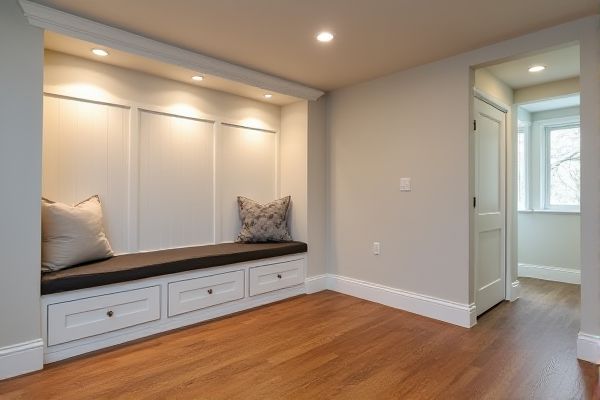
A built-in bench in a basement offers space-saving convenience and a seamless, custom look that maximizes your room's layout, while a freestanding bench provides flexibility in placement and easy relocation. Discover which option best suits your basement design needs as you explore the rest of this article.
Table of Comparison
| Feature | Built-in Bench Basement | Freestanding Bench Basement |
|---|---|---|
| Installation | Permanently integrated into basement structure | Independent, movable without construction |
| Space Efficiency | Maximizes available space; custom fit | Requires additional floor space; flexible placement |
| Design Customization | Fully customizable to basement dimensions and style | Limited to existing bench styles and sizes |
| Durability | Highly durable; built with permanent materials | Varies; depends on bench materials and quality |
| Cost | Higher upfront cost due to construction and customization | Lower cost; no construction needed |
| Flexibility | Fixed location; not easy to relocate | Easy to move and rearrange |
| Maintenance | Low maintenance; integrated design reduces damage risks | Requires regular cleaning and care; susceptible to damage |
| Use Case | Ideal for long-term seating solutions in basements | Suitable for temporary or multi-use basement setups |
Introduction to Basement Benches: Built-In vs Freestanding
Basement benches come in two primary styles: built-in and freestanding, each offering distinct benefits for your space. Built-in benches are integrated into the basement structure, providing a seamless look and maximizing space efficiency, while freestanding benches offer flexibility in placement and easy mobility. Choosing the right option depends on your basement's layout, storage needs, and design preferences.
Design Flexibility: Customization Options
Built-in benches in basements offer high design flexibility through seamless integration with existing walls, allowing for tailored dimensions, materials, and finishes that match the overall decor. Freestanding benches provide greater customization options in terms of mobility and style variations, enabling homeowners to easily rearrange seating or update with seasonal cushions and accessories. Both options accommodate personalized storage solutions, but built-ins maximize space efficiency while freestanding designs prioritize versatile placement.
Space Optimization and Layout
Built-in benches in basements maximize space efficiency by integrating seamlessly into walls or corners, allowing for customized storage solutions and minimizing clutter in tight areas. Freestanding benches provide flexible layout options as they can be easily moved or rearranged to accommodate different activities or changing room designs. Choosing between the two depends on prioritizing permanent space optimization with built-in units versus adaptable floor planning with freestanding furniture.
Installation Process and Requirements
Built-in benches in a basement require precise measurements, framing, and securing to walls or floors, often involving carpentry skills and potential electrical or plumbing adjustments. Freestanding benches offer simpler installation, needing only placement without permanent attachment, making them ideal for flexible layouts or DIY setups. Your choice impacts time, cost, and customization, with built-in options demanding more preparation but providing seamless integration.
Durability and Longevity Comparison
Built-in benches in basements offer superior durability due to their integration with the structure, reducing movement and wear over time compared to freestanding benches which are more prone to damage from shifts or moisture exposure. Materials like solid wood and reinforced concrete used in built-in benches enhance longevity by resisting warping and deterioration better than the lightweight materials often found in freestanding units. Properly sealed built-in benches also provide improved protection against basement humidity, ensuring a longer lifespan in damp conditions.
Cost Considerations and Budgeting
Built-in benches in basements typically involve higher upfront costs due to custom design, materials, and professional installation, but they offer long-term value through durability and seamless integration with the space. Freestanding benches are more budget-friendly initially, requiring less specialized labor and allowing flexibility for future relocation or replacement. Homeowners should weigh material expenses, installation fees, and long-term maintenance when budgeting for either option.
Maintenance and Cleaning Needs
Built-in benches in basements require less frequent deep cleaning due to their fixed placement, which minimizes dust accumulation in hard-to-reach areas. Freestanding benches often need more regular maintenance as they can collect dust and debris underneath and between legs, requiring thorough vacuuming and wiping. Both types benefit from using materials resistant to moisture and stains to ease ongoing cleaning efforts in basement environments.
Home Value and Resale Impact
Built-in benches in basements often enhance home value by providing a custom, integrated look that appeals to buyers seeking functional and stylish spaces. These permanent fixtures can increase resale potential by maximizing usable space and showcasing thoughtful design. In contrast, freestanding benches offer flexibility but may not contribute as significantly to perceived home value or long-term appeal during resale.
Style and Aesthetic Appeal
Built-in benches in basements offer a seamless, integrated look that maximizes space and complements the architectural design, often featuring custom materials and finishes tailored to the room's style. Freestanding benches provide versatile options that can be easily moved or updated, allowing for varied textures, colors, and designs that suit changing decor trends. The choice between these bench types significantly impacts the basement's visual cohesion and overall aesthetic appeal.
Choosing the Right Bench for Your Basement
Selecting the right bench for your basement depends on space, style, and functionality. Built-in benches maximize space and offer a seamless look, ideal for maximizing storage and creating a cozy atmosphere. Freestanding benches provide flexibility and easy relocation, perfect if you want to change your basement layout or add temporary seating.
 homyna.com
homyna.com